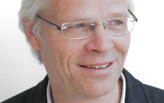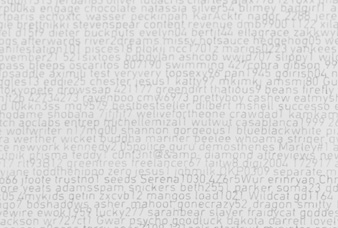POESIS - Language Art in the World of Data

"WELCOME WUTWUT WERTHER": three of 10,000 words, delicately written on a sheet of paper, in rows, with pencil, a pencil print respectively. These are passwords of Yahoo platform users; passwords that hackers had stolen and made public and that were , ironically thus, transformed into art, a piece of visual or post-digital poetry, by the German media artist Aram Bartholl in 2014. 1

Aram Bartholl: „123456“ (2014)
The work is a recent example of poetry that critically reflects the language culture in the age of computer network technology and Big Data. Such language art can be related to the program of Experimental Poetry that has been developed since the 1950s. Experimental Poetry engages with the material and use of the language itself and is interested in its relationship to information technology and postmodern communication conditions.
The example of Aram Bartholl stands for the tendency to break away from the obsession with computer hardware, that has pursued media and Internet art as well as electronic language art, and then, once again express oneself, by all means possible, in the analog realm of art. For poetry this means, that, conscious of the data world, one uses medially high variable modes of writing and articulation: from voice and handwriting, print on paper to multi-modal installations or interventions in public space.
Based on the possibilities offered by computer and Internet since the introduction of the World Wide Web, language art experienced a golden age in the German-speaking culture, in particular since the second half of the 1990s. There was a lively scene of so-called Net or Electronic Literature with different development trends that tested computer and the Internet for new, hyper medial, interactive, and collaborative realizations, as well as, for the discursive exchange of the communicating people in this field of art. 2 This scene received strong impetus through three contests organised by the weekly magazine, DIE ZEIT over 1996-1998. In the 2000s, the activity of Net Literature ebbed here in Germany again; it is currently the subject mainly of research and archival projects. 3
Not identical, overlapping in parts, at best, with net literature is the poetic language art, which has been working around the visual and media arts with digital language culture and was labeled with genre names such as ‘Digital’, ‘Electronic’, or ‘Computer Poetry’. Digital Poetry is internationally oriented per se, as is clear from the relevant forums, exhibitions, and symposia that took place in Germany and elsewhere. Actually, this genre as a genre is in particular a product of curatorial activity. 4
This should not diminish the importance assigned to Digital Poetry, particularly, in Germany: The first computer-generated poetic texts, the "Stochastic Texts" by Theo Lutz, originated in 1959 in the context of Concrete and Experimental Poetry. This art form has been advanced since the 1950s by artists such as Eugen Gomringer, Gerhard Ruehm, Franz Mon, Carlfriedrich Claus, and others. Experimental Poetry focuses primarily on the semiotic quality of language, on the visual and aural forms of letters and words, their syntax on the surface and in space, their semantics, and on the possibilities of language usage. This also includes the study of media technology such as radio, film, video, and the computer from early on. 5
Mentioned briefly for illustrative purposes are two projects of Digital poetry by German speaking artists, reflecting the tradition of experimental writing methods and at the same time digitally entangling with human activity: The "Stochastic Texts" by Theo Lutz, consisting of short computer-generated sentences were reprogrammed in 2005 by net artist Johannes Auer from Stuttgart and thus made accessible, and at the same time also expanded into the project "Search Lutz" where the lexical database can be augmented automatically by means of search engine submissions and actively by online users or where the texts are recited by an actress as they occur. 6

The Viennese language artist, Jörg Piringer combines a range of skills into dynamic, comprehensive works of art: He programs texts, designs animated typography, mixes his own software with live visuals and his vocal art in performances, like in case of his performance system "Nam Shub" (since 2005), where classical methods of Concrete, Visual, or Sound Poetry are programmed as algorithms for text generation. 7
Such language art is not absorbed in literature, as one of its peripheries, but poetry is rather justified as an art form of its own between the arts, whereby it is increasingly located in the social system of visual arts or even that of music, than in the system of literature that continues to be dominated by the book medium and the genre of the novel.
Mentioned briefly for illustrative purposes are two projects of Digital poetry by German speaking artists, reflecting the tradition of experimental writing methods and at the same time digitally entangling with human activity: The "Stochastic Texts" by Theo Lutz, consisting of short computer-generated sentences were reprogrammed in 2005 by net artist Johannes Auer from Stuttgart and thus made accessible, and at the same time also expanded into the project "Search Lutz" where the lexical database can be augmented automatically by means of search engine submissions and actively by online users or where the texts are recited by an actress as they occur. 6

The Viennese language artist, Jörg Piringer combines a range of skills into dynamic, comprehensive works of art: He programs texts, designs animated typography, mixes his own software with live visuals and his vocal art in performances, like in case of his performance system "Nam Shub" (since 2005), where classical methods of Concrete, Visual, or Sound Poetry are programmed as algorithms for text generation. 7
Such language art is not absorbed in literature, as one of its peripheries, but poetry is rather justified as an art form of its own between the arts, whereby it is increasingly located in the social system of visual arts or even that of music, than in the system of literature that continues to be dominated by the book medium and the genre of the novel.
References
- Cf. http://www.datenform.de/123456-eng.html
- Reference is made to the instructive overview of Beat Suter http://www.netzliteratur.net/suter/Geschichte_der_deutschsprachigen_Netzliteratur.pdf
- Cf. here https://adel.uni-siegen.de and https://www.dla-marbach.de/bibliothek/literatur-im-netz and for the discourse http://www.netzliteratur.net
- Cf. here. Especially the documentation on http://www.p0es1s.net . And Friedrich W. Block: p0es1s. Rückblick auf die digitale Poesie. Klagenfurt, Graz: Ritter 2015.
- Cf. For this poetic program the international collection of material on http://www.ubu.com
- http://searchlutz.netzliteratur.net
- http://joerg.piringer.net
Dr Friedrich W. Block is Director of the Brückner-Kühner-Foundation and the Kunsttempel in Kassel, Germany. He is the curator of numerous exhibitions, literary and academic events, and has also worked as an artist. Since 1992 he has been responsible for the "p0es1s" project on media poetry and since 2000 for the "Kasseler Komik Kolloquium". His research concentrates on contemporary literature, language art, and humor.
Friedrich W. Block, 2015
Translation Tina Gopal
Translation Tina Gopal



